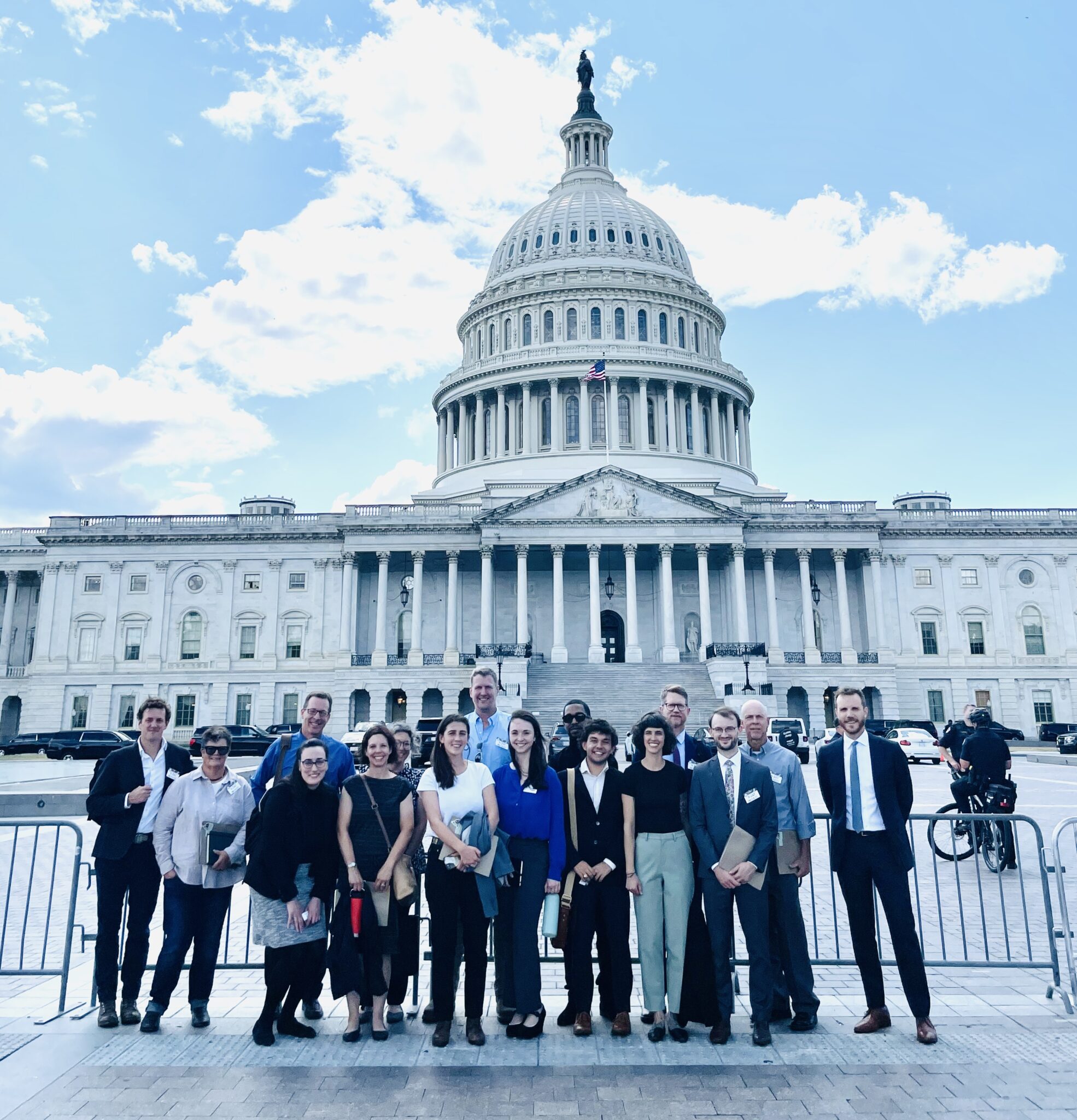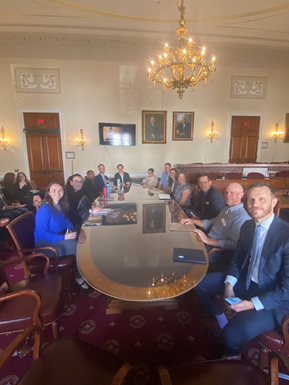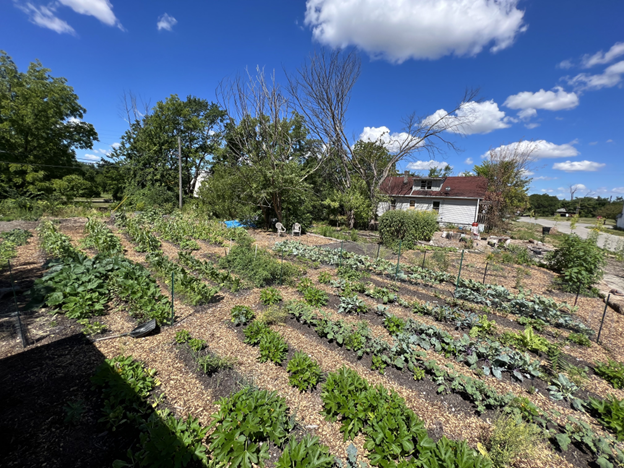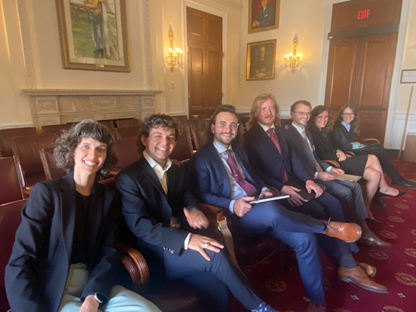Farmers on the Hill: Advocates and Farmers Join in Washington DC to Call for Food and Agriculture System Reform in the 2023 Farm Bill

As the House and Senate Agriculture Committees are busy working on their respective first drafts of the 2023 Farm Bill, farmers and advocates took an important opportunity to speak to Members of Congress about improved agriculture policy needs. Last week, NSAC hosted farmers, ranchers, and food system advocates from six states, who collectively attended nearly 20 meetings with Congressional offices and USDA officials, to share their stories and call for stronger, better-funded sustainable agriculture programs in the next farm bill.
“Fly-in” participants traveled to Washington DC from all over the country during the busy early summer season on their farms to ensure that their voices were heard in support of the programs that serve their operations. Participants flew in from Arkansas, Georgia, Iowa, Michigan, Minnesota, and Pennsylvania.
Across two days of meetings with Congress and USDA, farmers and advocates delivered an important message to officials in Washington, DC: the 2023 Farm Bill will be an essential vehicle with which to support farmers through investments in climate and conservation programs, improved crop insurance and credit opportunities, and expanded markets for local and regional foods.
One of the key targets for farmers and advocates was to visit the “four corners,” which include the chairs and ranking members of the Senate and House Agriculture Committees. Meeting with these Members of Congress offers one of the best opportunities to voice concerns about critical agriculture programs directly to those who are most influential in writing the next Farm Bill.
While the main focus of the fly-in was conservation and crop insurance programs, farmers and advocates also spoke about the importance of urban agriculture, organic farming, local and regional food systems, and climate challenges. This included voicing support for pieces of legislation like the Agriculture Resilience Act, the Strengthening Local Processing Act, and the Local Farms and Food Act. NSAC’s fly-in focused on three major campaigns: climate change, the farm safety net, and local and regional food systems. Each of these campaigns allowed visiting farmers and ranchers to relate specific policies to their farm stories and show Congress why reform is needed in the 2023 Farm Bill.

Beyond meeting with Members of Congress from their home states, visiting farmers and advocates also met with senior officials from USDA’s Natural Resources Conservation Service (NRCS). This meeting included conversations and storytelling about success stories with some of NRCS’s flagship programs, like the Conservation Stewardship Program (CSP) and the Environmental Quality Incentives Program (EQIP). Beyond the success stories though, farmers also shared the challenges they face with NRCS programs, including additional assistance needed to support beginning farmers in conservation efforts, and the complications of planting dates and other on-farm conservation practices that promote good resource stewardship on agricultural land.
Addressing the Climate Crisis
One of the key themes that emerged from fly-in participants was the impact that changes in climate have on farmers. In fact, climate change poses one of the greatest risks to farms across the United States. Whether farmers and ranchers face increasingly frequent natural disasters, altered seasonal weather, or long-term environmental changes, agriculture is particularly vulnerable to climate change, threatening reliable food production and jeopardizing farmers’ livelihoods. However, farmers and ranchers are also at the forefront of the solutions to address the climate crisis on farms.

The Agriculture Resilience Act (ARA) includes provisions that will reduce greenhouse gas emissions from agriculture by supporting farmers and ranchers with farm-driven, science-based means to meet climate goals. These include a variety of actions and strategies, including investing in farmer-centered research, incentivizing on-farm conservation programs, increasing funds for local agricultural markets and agricultural easements, expanding pasture-based livestock, and building out on-farm renewable energy production. As a comprehensive bill, the ARA offers many ways in which farmers and ranchers can be at the forefront of addressing climate change, while also improving the resiliency of their operations.
In addition to the Agriculture Resilience Act, farmer and rancher advocates spoke to Congressional offices about Working Lands Conservation programs, which provide farmers with financial and technical assistance to implement conservation practices on their farms to improve soil health, water quality, and other environmental factors.
Farmer Jøn Kent of Sanctuary Farms in Michigan shared in a meeting with House Agriculture Committee chair GT Thompson’s (R-PA-15) office that while he and many of his fellow urban farmers want to get involved in conservation, many struggle to access these programs. “We applied along with many others, and we actually got an EQIP contract. But we were an anomaly. I want to know what Congress can do to help me and other urban farmers access these conservation programs,” Jøn said.

Other fly-in participants shared their success stories with USDA directly. Cody Hopkins of Grassroots Coop in Arkansas said, “The EQIP contract has been great for us, but we still need more expertise in silvopasture and livestock technical assistance.”

Farmer Angela Smith of Middle Fork Farm in Minnesota also shared her gratitude for how NRCS conservation programs have helped her implement good resource stewardship practices on her small vegetable farm.
Both working lands conservation programs and the Agriculture Resilience Act address the most fundamental climate and environment needs of farmers and ranchers. By investing in these programs in the 2023 Farm Bill reauthorization process, Congress will ensure that farms can withstand the pressures of a changing climate.
Finding Common Ground on Farm Safety Net Reform
Another theme that arose throughout the fly-in was the need for changes to the farm safety net. Participants shared challenges they face with both agricultural credit and crop insurance programs.
On the topic of land access for new and beginning farmers and ranchers, Adrienne Nelson, a farmer from Pennsylvania and organizer with the National Young Farmers Coalition shared, “We’ve heard good feedback from the applications that FSA has adjusted, but we also want them to consider doing a pre-approval process. Because land is selling so fast, ensuring that people are well-positioned to purchase is really valuable.”
NSAC encourages Congress to use the 2023 Farm Bill reauthorization process to make a number of reforms to agricultural credit programs that will benefit new and beginning farmers, much like Nelson shared. These provisions include a study about creating a pre-approval process for farmers, eliminating eligibility exclusions for new farmers based on previous debts, strengthening FSA staff capacity to address non-conventional producers and farmer appeals, and establishing new models for lending that promotes on-farm resilience.
The farm safety net also encompasses crop insurance programs. While many of the largest, wealthiest farms are receiving significant crop insurance subsidies to support less sustainable, monoculture-based operations, smaller, more-diversified farmers struggle to find crop insurance products for which they qualify, and that adequately insure their farms. Whole Farm Revenue Protection, created in the 2014 Farm Bill, is one of the best crop insurance products for these farmers because it offers the opportunity for producers to ensure their entire operations with one comprehensive insurance policy. However, due to bureaucratic barriers, burdensome paperwork, and a lack of outreach from USDA, enrollment in Whole Farm Revenue Protection has declined by 45% since 2017.
Michael Wall, of Georgia Organics, spoke to the difficulty of obtaining a Whole Farm Revenue Protection insurance policy. “I’ve tried calling every crop insurance agent in the state of Georgia. Either I can’t get a hold of anyone, they send me to someone else, or they just don’t sell the policy because there is no incentive for the agent to do so.”
Farmer and crop insurance agent, Landon Plagge of Green Acres Seed Co. in Iowa, concurred. “I am a crop insurance agent as well as a farmer. I would never sell a Whole Farm policy because the commission sucks. If there was an incentive for the program, then it might be different. Plus, I’m getting guarantees on 80% to 90% of my crop with my crop insurance policy. We really don’t need that. Instead, we can offer more reasonable and practical insurance policies and put those saved resources to better use.”
Expanding insurance options like Whole Farm Revenue Protection for smaller, diverse, and specialty crop farms is one of the best ways that Congress can leverage the 2023 Farm Bill to promote natural resource stewardship and establish a fairer, more even playing field for all farmers.
Supporting Local and Regional Food Systems
Since the COVID-19 pandemic, the need for resilient, local food systems has never been more pronounced. Many fly-in participants shared how enhancing programs that support local and regional food production creates more vibrant communities where nutritious local food grown in environmentally sustainable ways is available to all people.
Most critically, investments in local and regional food systems must increase market opportunities for local farmers and processors, promote economic development, and ensure sustainable supply chains. The 2023 Farm Bill presents an opportunity to codify programs that offer greater technical and financial assistance to farmers and processors contributing to locally resilient food systems, build local capacity to prioritize regional food production, and provide access to nutritional food for both rural and urban communities.
NSAC has supported the introduction of two pieces of legislation that address these local and regional food systems needs. The Local Farms and Food Act includes provisions to expand equitable access to the Local Agriculture Market Program (LAMP) through opportunities like turnkey grants and simplified application and match requirements; supporting unmet infrastructure needs and value chain coordination; and expanding the reach of nutrition programs like the Senior Farmers Market Nutrition Program (SrFMNP).
In addition to expanding resources for local food markets, improving local processing infrastructure is an essential component of a more resilient local food system. The Strengthening Local Processing Act (SLPA) is a marker bill that supports good jobs and reduces burdens for farmers seeking processing services. The bill creates workforce training programs in meat processing to address worker shortages, expands interstate trade opportunities for meat producers, provides technical assistance to support the scaling up of existing and new local meat processing plants, and in turn increases local meat processing capacity.
Mark Smith, of Pittsburgher Highland Farm in Pennsylvania, emphasized the need for local meat processing resources while he was in Washington DC. “Greater flexibility in rules and regulations and process would be really helpful. It seems like USDA is one size fits all. As a meat producer, we use processors. Small and medium-sized processors struggle to get through the system. We lost many of our processors in 2020 because there are too many barriers to entry for butcher inspectors.”
By supporting legislation that increases the capacity and resilience of local food systems, Members of Congress can promote communities’ abilities to respond to local processing and nutrition needs while building their economies and creating more market opportunities for farmers and ranchers.
Continuing the Fight for a Better Farm Bill

The current farm bill is set to expire on September 30, 2023. Right now, Members of Congress on the House and Senate Agriculture Committees are working to develop their drafts of the 2023 Farm Bill. Until these drafts or “marks” are released though, Members of Congress continue to introduce “marker bills,” bills that introduce ideas for the farm bill, but are not meant to pass as legislation on their own. Further, there is still time and opportunity for farmers, ranchers, and sustainable food system advocates to share their stories and encourage congressional champions to make important investments in a more sustainable, equitable, and resilient food and farm landscape. By collaborating with dedicated farmers like those who came for this fly-in, NSAC and our partners are excited to build stronger and better policies that benefit all people with a sustainable and accessible food and farm system.
The post Farmers on the Hill: Advocates and Farmers Join in Washington DC to Call for Food and Agriculture System Reform in the 2023 Farm Bill appeared first on National Sustainable Agriculture Coalition.
